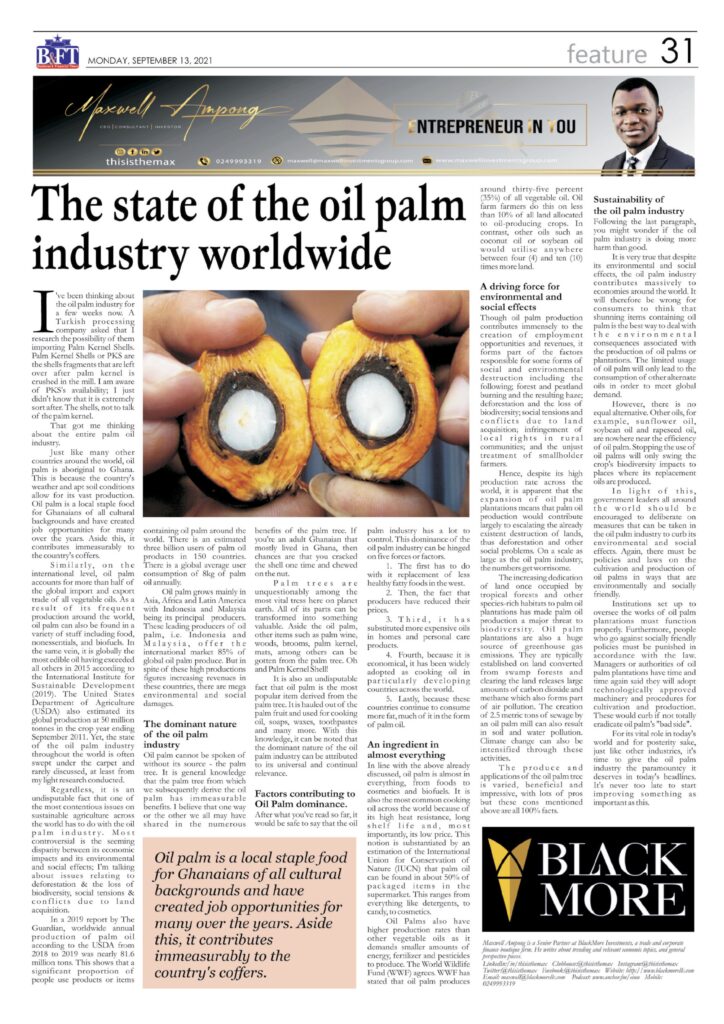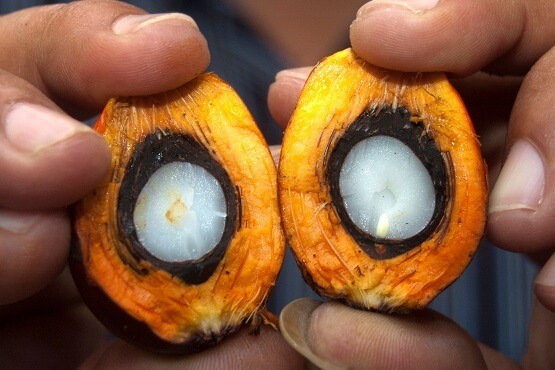
Just like many other countries around the world, oil palm is aboriginal to Ghana. This is because, the country’s weather and apt soil conditions allow for its vast production. Oil palm is a local staple food for Ghanaians of all cultural backgrounds and have created job opportunities for many over the years. Aside this, it contributes immeasurably to the country’s coffers.
I’ve been thinking about the oil palm industry for a few weeks now. A Turkish processing company asked that I research the possibility of them importing Palm Kernel Shells. Palm Kernel Shells or PKS are the shells fragments that are left over after palm kernel is crushed in the mill. I am aware of PKS’s availability; I just didn’t know that it is extremely sort after. The shells, not to talk of the palm kernel.
That got me thinking about the entire palm oil industry.
On the international level, oil palm accounts for more than half of the global import and export trade of all vegetable oils. As a result of its frequent production around the world, oil palm can also be found in a variety of stuff including food, nonessentials, and biofuels. In the same vein, it is globally the most edible oil having exceeded all others in 2015 according to the International Institute for Sustainable Development (2019). The United States Department of Agriculture (USDA) also estimated its global production at 50 million tonnes in the crop year ending September 2011. Yet, the state of the oil palm industry throughout the world is often swept under the carpet and rarely discussed, at least from my light research conducted.
Regardless, it is an undisputable fact that one of the most contentious issues on sustainable agriculture across the world has to do with the oil palm industry. Most controversial is the seeming disparity between its economic impacts and its environmental and social effects; I’m talking about issues relating to deforestation & the loss of biodiversity, social tensions & conflicts due to land acquisition.
In a 2019 report by The Guardian, worldwide annual production of palm oil according to the USDA from 2018 to 2019 was nearly 81.6 million tons. This shows that a significant proportion of people use products or items containing oil palm around the world. There is an estimated three billion users of palm oil products in 150 countries. There is a global average user consumption of 8kg of palm oil annually.
Oil palm grows mainly in Asia, Africa and Latin America with Indonesia and Malaysia being its principal producers. These leading producers of oil palm, i.e. Indonesia and Malaysia, offer the international market 85% of global oil palm produce. But in spite of these high productions figures increasing revenues in these countries, there are mega environmental and social damages.
The dominant nature of the oil palm industry
Oil palm cannot be spoken of without its source – the palm tree. It is general knowledge that the palm tree from which we subsequently derive the oil palm has immeasurable benefits. I believe that one way or the other we all may have shared in the numerous benefits of the palm tree. If you’re an adult Ghanaian that mostly lived in Ghana, then chances are that you cracked the shell one time and chewed on the nut.
Palm trees are unquestionably among the most vital tress here on planet earth. All of its parts can be transformed into something valuable. Aside the oil palm, other items such as palm wine, woods, brooms, palm kernel, mats, among others can be gotten from the palm tree. Oh and Palm Kernel Shell!
It is also an undisputable fact that oil palm is the most popular item derived from the palm tree. It is hauled out of the palm fruit and used for cooking oil, soaps, waxes, toothpastes and many more. With this knowledge, it can be noted that the dominant nature of the oil palm industry can be attributed to its universal and continual relevance.
Factors contributing to Oil Palm dominance.
After what you’ve read so far, it would be safe to say that the oil palm industry has a lot to control. This dominance of the oil palm industry can be hinged on five forces or factors.
- The first has to do with it replacement of less healthy fatty foods in the west.
- Then, the fact that producers have reduced their prices.
- Third, it has substituted more expensive oils in homes and personal care products.
- Fourth, because it is economical, it has been widely adopted as cooking oil in particularly developing countries across the world.
- Lastly, because these countries continue to consume more fat, much of it in the form of palm oil.
An ingredient in almost everything
In line with the above already discussed, oil palm is almost in everything, from foods to cosmetics and biofuels. It is also the most common cooking oil across the world because of its high heat resistance, long shelf life and, most importantly, its low price. This notion is substantiated by an estimation of the International Union for Conservation of Nature (IUCN) that palm oil can be found in about 50% of packaged items in the supermarket. This ranges from everything like detergents, to candy, to cosmetics.
Oil Palms also have higher production rates than other vegetable oils as it demands smaller amounts of energy, fertilizer and pesticides to produce. The World Wildlife Fund (WWF) agrees. WWF has stated that oil palm produces around thirty-five percent (35%) of all vegetable oil. Oil farm farmers do this on less than 10% of all land allocated to oil-producing crops. In contrast, other oils such as coconut oil or soybean oil would utilise anywhere between four (4) and ten (10) times more land.
A driving force for environmental and social effects
Though oil palm production contributes immensely to the creation of employment opportunities and revenues, it forms part of the factors responsible for some forms of social and environmental destruction including the following; forest and peatland burning and the resulting haze; deforestation and the loss of biodiversity; social tensions and conflicts due to land acquisition; infringement of local rights in rural communities; and the unjust treatment of smallholder farmers.
Hence, despite its high production rate across the world, it is apparent that the expansion of oil palm plantations means that palm oil production would contribute largely to escalating the already existent destruction of lands, thus deforestation and other social problems. On a scale as large as the oil palm industry, the numbers get worrisome.
The increasing dedication of land once occupied by tropical forests and other species-rich habitats to palm oil plantations has made palm oil production a major threat to biodiversity. Oil palm plantations are also a huge source of greenhouse gas emissions. They are typically established on land converted from swamp forests and clearing the land releases large amounts of carbon dioxide and methane which also forms part of air pollution. The creation of 2.5 metric tons of sewage by an oil palm mill can also result in soil and water pollution. Climate change can also be intensified through these activities.
The produce and applications of the oil palm tree is varied, beneficial and impressive, with lots of pros but these cons mentioned above are all 100% facts.
Sustainability of the oil palm industry
Following the last paragraph, you might wonder if the oil palm industry is doing more harm than good.
It is very true that despite its environmental and social effects, the oil palm industry contributes massively to economies around the world. It will therefore be wrong for consumers to think that shunning items containing oil palm is the best way to deal with the environmental consequences associated with the production of oil palms or plantations. The limited usage of oil palm will only lead to the consumption of other alternate oils in order to meet global demand.
However, there is no equal alternative. Other oils, for example, sunflower oil, soybean oil and rapeseed oil, are nowhere near the efficiency of oil palm. Stopping the use of oil palms will only swing the crop’s biodiversity impacts to places where its replacement oils are produced.
In light of this, government leaders all around the world should be encouraged to deliberate on measures that can be taken in the oil palm industry to curb its environmental and social effects. Again, there must be policies and laws on the cultivation and production of oil palms in ways that are environmentally and socially friendly.
Institutions set up to oversee the works of oil palm plantations must function properly. Furthermore, people who go against socially friendly policies must be punished in accordance with the law. Managers or authorities of oil palm plantations have time and time again said they will adopt technologically approved machinery and procedures for cultivation and production. These would curb if not totally eradicate oil palm’s “bad side”.
For its vital role in today’s world and for posterity sake, just like other industries, it’s time to give the oil palm industry the paramountcy it deserves in today’s headlines. It’s never too late to start improving something as important as this.
I hope you found this article insightful and enjoyable. Subscribe to the ‘Entrepreneur In You’ newsletter here: https://lnkd.in/d-hgCVPy.
I wish you a highly productive and successful week ahead!
♕ —- ♕ —- ♕ —- ♕ —- ♕
Disclaimer: The views, thoughts, and opinions expressed in this article are solely those of the author, Dr. Maxwell Ampong, and do not necessarily reflect the official policy, position, or beliefs of Maxwell Investments Group or any of its affiliates. Any references to policy or regulation reflect the author’s interpretation and are not intended to represent the formal stance of Maxwell Investments Group. This content is provided for informational purposes only and does not constitute legal, financial, or investment advice. Readers should seek independent advice before making any decisions based on this material. Maxwell Investments Group assumes no responsibility or liability for any errors or omissions in the content or for any actions taken based on the information provided.


